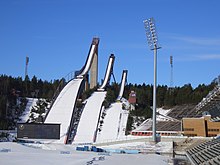Lahti
The village belonged to the parish of Hollola and was located at the medieval trade route of Ylinen Viipurintie, which linked the towns of Hämeenlinna and Viipuri.The completion of the Riihimäki – St. Petersburg railway line in 1870 and the Vesijärvi canal in 1871 turned Lahti into a lively station, and industrial installations began to spring up around it.However, the accident proved to be a stroke of luck for the development of the place, as it led to the authorities resuming their deliberations about establishing a town in Lahti.The Battle of Lahti was fought in the 1918 Finnish Civil War as the German Detachment Brandenstein took the town from the Reds.The increase in population was especially strong after WWII, when 10,000 evacuees from ceded territories to the Soviet Union were settled in the city, and then later in the 1960s and 1970s as a result of urbanization.The terrain of Lahti is dominated by the first Salpausselkä ridge, a terminal moraine that cuts through the city from west to east.The city is located in the transition from the southern coastal area to the Finnish Lakeland; prominent to the north of the Salpausselkä are rocky hills and fragmented lakes, while its south side is dominated by forests and small rivers.Summers are usually warm in the city, with the average daily temperature in July exceeding over 23 °C (73.6 °F) and also having had the most 25 °C (77 °F) (or more) days in the last two decades, alongside Kouvola.FMI(record highs and lows 1938–1961)[24] The city of Lahti has 121,383 inhabitants, making it the 9th most populous municipality in Finland.[25] As English and Swedish are compulsory school subjects, functional bilingualism or trilingualism acquired through language studies is not uncommon.[28] The economic region of Lahti, which includes the surrounding municipalities, was strongly affected by the collapse of Finnish-Soviet trade and by the recession in the early 1990s.The amount of Tekes (the National Technology Agency) funding in the Lahti Region grew 40% during 2004–2007 while the average growth in Finland was 60%.Lahti harbors cultural ambitions, manifested notably in the construction of a large congress and concert centre, the Sibelius Hall (2000) by architects Kimmo Lintula and Hannu Tikka.Many former NHL players, such as Janne Laukkanen, Toni Lydman and Pasi Nurminen, have started their careers in Reipas.Their greatest rivals, Reipas, won a total of three championships and seven cup titles from 1963 to 1978 but diminished in the early 1980s as Kuusysi got stronger.FC Lahti has played in the Veikkausliiga since 1999, excluding a season-long visit to the first division in 2011, having placed twice third and appearing in Europe three times.A local service to Heinola has been proposed but renovating the old line has been deemed too expensive and unprofitable in the long term, unless the Finnish state reaches an agreement with regional councils to finance a direct rail link from Lahti to either Jyväskylä or Mikkeli.The city's main transportation hubs are the market square (Kauppatori) and the travel centre (Matkakeskus), with local buses providing a non-stop service between the two.All local and long-distance trains and buses stop at the travel centre, making it convenient to transfer from one mode of transport to another.From Lahti, the long-distance busses service routes to Helsinki, Turku, Tampere, Jyväskylä, Mikkeli, Oulu, Rovaniemi amongst the other destinations.All four upper secondary schools in Lahti have a specialty: the Lyceum has expertise on subjects such as mathematics and biology, and sports (formerly in Salpauselkä), Tiirismaa focuses on music in association with the Lahti Conservatory, Kannas organises theatre classes and Lahden yhteiskoulu offers an economy-centered class.The privately owned Dila and Lahti Conservatory educate students for healthcare and music-related professions, respectively.










Lahti L-39Lahti (surname)FinlandRegionPäijänne TavastiaSub-regionCharterCity manager191st largest9th largestPopulation by native languageFinnishSwedishPopulation by ageTime zonePäijät-HämeFinnish Lakelandmunicipalityurban areaVesijärviHelsinkiHeinolaHämeenlinnaTavastia Proper (Kanta-Häme)Highway 4JyväskyläHighway 12TampereKouvolaAsikkalaHollolaOrimattilaChicagoslaughterhouse citiesEuropean CommissionEuropean Green CapitalUNESCO Global Geoparkscoat of armsRiihimäki–Saint Petersburg railwayparishViipuriRiihimäki – St. Petersburg railway linemarket townAlexander II of RussiaboulevardsRussian EmpireTurkeyGrand Duchy of FinlandSenateTsar Nicholas IIBattle of LahtiFinnish Civil WarDetachment BrandensteinWinter Warceded territoriesSoviet UnionNastolaRovaniemiLUT UniversityLappeenrantaLake VesijärviSalpausselkämoraineCentral FinlandLake PäijännePikku-VesijärviLanu-puistoKeski-LahtiKartanoPaavolaKiveriöKivimaaMukkulaKilpiäinenKytöläAhtialaMöysäJärvenpääKolavaÄmmäläRenkomäkiAsemantaustaSopenkorpiHennalaUusikyläKöppen climate classificationhumid continental climateprecipitationLahti regionVantaaFinnish-speakingSwedish speakersEnglishRussianArabicEstonianKurdishEstoniaRussiaSwedenThailandformer Soviet UnionEvangelical Lutheran ChurchSibelius HallLahti Symphony OrchestraJean SibeliusBBC Radio 3Eliel SaarinenChurch of the CrossAlvar AaltoJoutjärvi churchPekka SalminenArto SipinenGert WingårdhJKMM ArchitectsSpirit of Wood Architecture AwardKengo KumaRichard LeplastrierKorpiklaaniLahti Ski MuseumLahti Art MuseumRadio and TV MuseumFinland's Motorcycle MuseumTaarasti Art CenterSki jumpsHiihtostadium